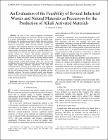| dc.contributor.author | Pavia, Sara | |
| dc.contributor.author | Alelweet, Omar | |
| dc.date.accessioned | 2020-02-05T15:59:27Z | |
| dc.date.available | 2020-02-05T15:59:27Z | |
| dc.date.created | Dec. 16-17 | en |
| dc.date.issued | 2019 | |
| dc.date.submitted | 2019 | en |
| dc.identifier.citation | Alelweet, O. & Pavia, S., An evaluation of the feasibility of industrial wastes and natural materials, as precursors, for the production of alkali activated materials (AAMs), ICNMTA 2019: XIII Int. Conf. on Civil, Structural and Construction Engineering, Barcelona, Dec. 16-17, 2019 | en |
| dc.identifier.other | Y | |
| dc.identifier.uri | https://publications.waset.org/10010965/an-evaluation-of-the-feasibility-of-several-industrial-wastes-and-natural-materials-as-precursors-for-the-production-of-alkali-activated-materials | |
| dc.identifier.uri | http://hdl.handle.net/2262/91462 | |
| dc.description.abstract | In order to face current compelling environmental
problems affecting the planet, the construction industry needs to adapt.
It is widely acknowledged that there is a need for durable, highperformance,
low-greenhouse gas emission binders that can be used as
an alternative to Portland cement (PC) to lower the environmental
impact of construction. Alkali activated materials (AAMs) are
considered a more sustainable alternative to PC materials. The binders
of AAMs result from the reaction of an alkali metal source and a
silicate powder or precursor which can be a calcium silicate or an
aluminosilicate-rich material. This paper evaluates the particle size,
specific surface area, chemical and mineral composition and
amorphousness of silicate materials (most industrial waste locally
produced in Ireland and Saudi Arabia) to develop alkali-activated
binders that can replace PC resources in specific applications. These
include recycled ceramic brick, bauxite, illitic clay, fly ash and
metallurgical slag. According to the results, the wastes are reactive and
comply with building standards requirements. The study also
evidenced that the reactivity of the Saudi bauxite (with significant
kaolinite) can be enhanced on thermal activation; and high calcium in
the slag will promote reaction; which should be possible with low
alkalinity activators. The wastes evidenced variable water demands
that will be taken into account for mixing with the activators. Finally,
further research is proposed to further determine the reactive fraction
of the clay-based precursors. | en |
| dc.language.iso | en | en |
| dc.rights | Y | en |
| dc.subject | Reactivity | en |
| dc.subject | Water demand | en |
| dc.subject | Alkali-activated material | en |
| dc.subject | Brick | en |
| dc.subject | Bauxite | en |
| dc.subject | Illitic clay | en |
| dc.subject | Fly ash | en |
| dc.subject | Slag | en |
| dc.title | An evaluation of the feasibility of industrial wastes and natural materials, as precursors, for the production of alkali activated materials (AAMs) | en |
| dc.title.alternative | ICNMTA 2019: XIII Int. Conf. on Civil, Structural and Construction Engineering | en |
| dc.type | Conference Paper | en |
| dc.type.supercollection | scholarly_publications | en |
| dc.type.supercollection | refereed_publications | en |
| dc.identifier.peoplefinderurl | http://people.tcd.ie/pavias | |
| dc.identifier.rssinternalid | 211530 | |
| dc.rights.ecaccessrights | openAccess | |
| dc.subject.TCDTheme | Nanoscience & Materials | en |
| dc.subject.TCDTheme | Smart & Sustainable Planet | en |
| dc.identifier.orcid_id | 0000-0003-4506-8386 | |
| dc.status.accessible | N | en |




